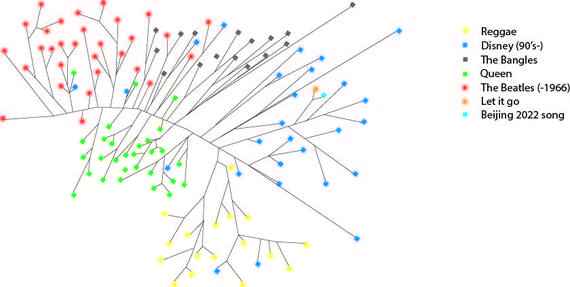I was recently asked for my opinion as a scientist about whether the official Beijing 2022 Winter Olympic song, which was included in the bid for hosting the games, borrowed ideas from Elsa's (Idina Menzel) "Let It Go", part of Disney's Frozen soundtrack.
When I first listened to the two songs I was surprised by the question. The songs have the same structure, similar chord sequence, beat, sound, and the piano riff is exceptionally similar. Similar chord sequence is definitely not sufficient to suspect plagiarism, as some chord sequences such as C-F-C-G or C-Am-F-G have been used by hundreds of songs. However, the official Beijing 2022 song is similar to "Let It Go" in more than merely the chord sequence, and I cannot think of a person listening to the two songs without noticing the similarity. To convince myself further I played the song to my two daughters and asked them what other song it reminded them. Although I am not even sure they fully understood the question, the answer was quick and decisive -- "Elsa!"
As we all know, the real purpose of the social sciences is to say the obvious in a sophisticated fashion that makes it sound scientific. Given that computers are capable of analyzing music , I was curious about the "opinion" of the computer about the similarity between the two songs.
The database of the experiment included songs of The Beatles (until 1966), Queen, The Bangles, Reggae songs and some Disney songs from the 1990s or later. The reason for using songs from several different categories is that the computer can use the different musical styles to identify patterns that are common to one type of songs but less common in other songs. In the artificial intelligence jargon it is called "supervised learning".
Since each song is represented by a set of almost 3,000 numerical values, it is possible to compare the difference between each pair of songs by comparing difference between the sets of numbers. The Euclidian distance is a ~2,300 year-old technology that can compute the distance between two points regardless of the number of dimensions in the hyperplane. The Euclidian distances between all pairs of songs provides a matrix of all similarity values between all songs in the database. Then, these similarities are visualized by transforming the matrix of similarities into a graph such that a shorter line (or path) between two songs reflects a higher similarity between them.
The graph shows that the computer was able to roughly differentiate between the songs, and most of the Disney songs are clustered together. The graph also shows that "Let It Go" and the official Beijing 2022 Olympic song are positioned very close to each other. In fact, there are no two other Disney songs as similar to each other as these two songs. But is it a proof for plagiarism? Probably not. Proving plagiarism scientifically in this case requires a journey inside the mind of the composer and music producer, who might also be the victim of cryptomnesia (subconscious plagiarism). The computer is not sufficient to determine the difference between plagiarism and legitimate musical influential links.
